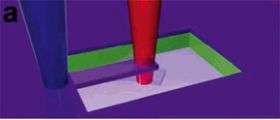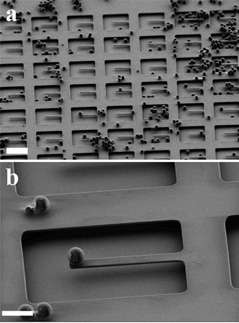Side-to-side shaking of nanoresonators throws off impurities

Tiny vibrating silicon resonators are of intense interest in nanotechnology circles for their potential ability to detect bacteria, viruses, DNA and other biological molecules.
Cornell researchers have demonstrated a new way to make these resonators vibrate "in the plane" -- that is, side to side -- and have shown that this can serve a vital function: shaking off extraneous stuff that isn't supposed to be detected.

The research is reported in the July 14 online version of the journal Nano Letters and in the August print edition.
The typical resonator is a cantilever -- a narrow strip of silicon a few millionths of a meter long that can be made to vibrate up and down like a diving board just after someone jumps off. In research aimed at building the much-sought "lab on a chip," Professor Harold Craighead's group at Cornell and other researchers have shown that by binding antibodies to such resonators they can cause pathogens to attach to them. At the nanoscale, just adding the mass of one bacterium, virus or large molecule is enough to change the resonant frequency of vibration of the cantilever by a measurable amount, thereby signaling the presence of the pathogen.
But "If, for example, you are trying to detect E. coli, there will be more things in the fluid than E. coli, and they can weakly absorb on the detector by electrostatic forces. This is a problem in any sort of biodetection," explained B. Rob Ilic, a researcher in the Cornell NanoScale Facility. The answer, he said, is to make the resonator vibrate from side to side. This will shake off loosely adhered materials, while whatever is tightly bound to an antibody will stay put.
Ilic and colleagues made cantilevers about a micron (millionth of a meter) wide, 5 or 10 microns long and 200 nanometers (billionths of a meter) thick, suspended over an empty space about a micron deep. When energy was pumped in from a laser or by an attached vibrating piezoelectric crystal, the cantilevers vibrated up and down at a resonant frequency that depended on their dimensions and mass.
Then the researchers demonstrated that in-plane motion can be created by hitting the base of the cantilever with a laser pulsed at the resonant frequency of the cantilever's in-plane vibration, which is different from the resonant frequency of its vibration perpendicular to the plane. To measure in-plane motion the researchers shined another laser on the free end of the cantilever and detected the chopping of the beam as the cantilever moved from side to side.
To show that in-plane motion could shake unwanted materials off of biosensors, the researchers distributed polystyrene spheres ranging from half a micron to a micron in diameter onto an array of cantilevers. The spheres, which attached themselves by electrostatic attraction, were removed by in-plane shaking. But when the cantilevers were made to vibrate more intensely up and down -- even so far that they bumped the "floor" below -- the spheres did not budge, nor did they during spinning of the entire chip.
In-plane vibration also could be used to determine how strongly particles are bound to the surface by observing how hard they need to be shaken to come loose, Ilic said. The ability to excite in-plane motion also has applications in making nanoscale gyroscopes, in nano optics and for basic physics experiments, he added.
Co-authors with Ilic and Craighead, who is the Charles W. Lake Jr. Professor of Engineering and professor of applied and engineering physics at Cornell, are Slava Krylov, professor in the Department of Solid Mechanics, Materials and Systems at Tel Aviv University, and Marianna Kondratovich, an undergraduate researcher in Cornell's Department of Mechanical and Aerospace Engineering.
Source: Cornell University





















